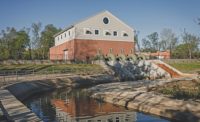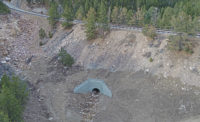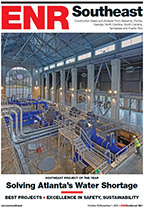Mile Point Training Wall Reconfiguration
Jacksonville, Fla.
Best Project
Owner: USACE Jacksonville District
Lead Design Firm: COWI North America Inc.
General Contractor: Manson Construction Co.
Located at the confluence of the St. Johns River and the Atlantic Intracoastal Waterway, this project restored local, historic channel flow and marshlands through the creation of a 4,000-ft-long west leg training wall as well as the approximately 2,100-ft-long east leg training wall. Contractors’ use of dredging aided in redirecting the currents while also significantly improving navigation of the St. Johns River. The project team also used dredge spoils to construct several additional acres of marshland beyond the Corps of Engineers’ mitigation requirement of approximately 19 acres.
Acting as both a wave attenuation structure and a protective barrier for newly created wetlands, the west leg training wall consists of 504 contiguously concrete structural units (CSUs) placed atop a structured geogrid of stone-filled marine mattresses. Erosion from the area’s strong currents constantly altered the west wall “foundation,” requiring two revisions to the structure’s alignment after construction got underway. In order to avoid a third adjustment, the project team armored the underlying virgin material with riprap stone.
Prior to constructing the east leg training wall, contractors excavated a 3,300-ft-long training wall built of armor stone—estimated to be 100 years old. Crews were able to reuse some of the existing armor stone, along with newly imported armor stone material, placing it along the new east leg training wall alignment. Smaller stone from the excavated wall was repurposed to build an inner 2-ft-thick core along the entire length of the new structure. Reuse of the “found” material ultimately increased the wall’s lower toe and upper crest, drastically bolstering the entire structure.
The majority of the onsite work was conducted from a small armada of boats and barges, using an array of construction tools that included barge-mounted cranes and an excavator, three dredges, specialized lifting and positioning equipment fitted with GPS and hydraulically actuated release mechanisms and state-of-the-art survey gear. Utilizing remote controls to accurately place the CSUs made for a safer and more efficient construction process, eliminating the risks of having divers work around live loads.
Although speed was essential to construct these environmental safeguards, nature proved to be the ultimate site “superintendent.” Manatee sightings halted operations more than 100 times, while shorebird dredged spoils were carefully disposed within one of Florida’s largest shorebird nesting areas.









Post a comment to this article
Report Abusive Comment